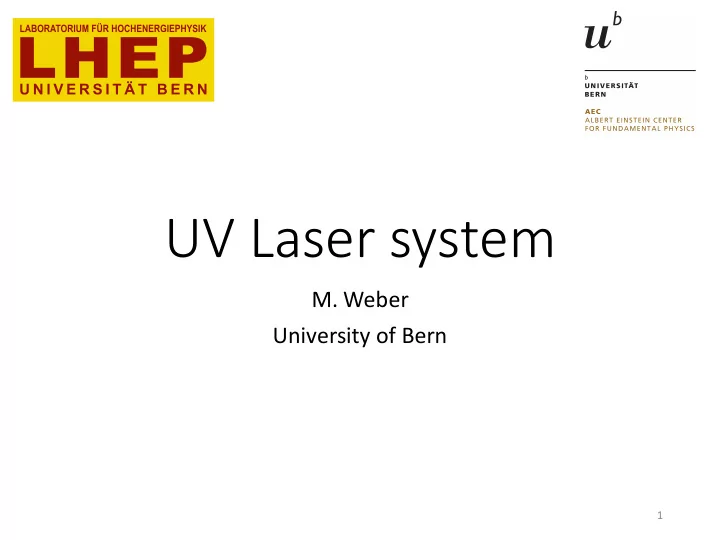

UV Laser system M. Weber University of Bern 1
Calibration needs multiple tools… ! • Options (not exhaustive): • Purity monitors • Gas analyzers • Temperature monitors • Survey of TPC • Electric field (HV, resistor chain) measurement • Use cosmic muon tracks • Test beams • Laser tracks -> straight tracks, reproducible, no delta rays, no MCS, no recombination • Make use of the specific characteristics and dependencies of all of the above in a combined way 2
How to ionize Argon with the UV laser • 266nm <-> 4.7 eV • For ionization, an energy of 13.4 eV (84 nm) wavelength laser is required • Multi-photon transition via a quasi resonant state at 9.32eV • Requires enough flux of photons, i.e. strong laser 3
UV laser calibration system Primary beam generator JINST 4 (2009) P07011 New J.Phys. 12 (2010) 113024 Primary Source: Nd:YAG laser, with frequency multiplication: Output beam 266 nm , ~60 mJ/pulse, 5 ns. Maximum repetition rate 10 Hz. Beam divergence 0.5 mrad Beam diameter about 5 mm 4
Effects contributing to the observable ionization • Beam divergence: nominal 0.5 mrad (can change at the mirrors!) • Beam absorption: does not seem to be an issue… l att > 100 m at 266 nm “Attenuation of vacuum ultraviolet light in liquid argon” , Eur. Phys. J. C (2012) • Rayleigh scattering (40m at 266 nm) • Refraction on density gradients • Non-linear effects (Kerr-induced self-focusing) 5
UV UV laser calibrati tion on sy system: Conceptual des design Goal: to provide straight ionisation tracks Tool: multiple UV lasers, each with steerable mirror feed-through 6
7
MicroBooNE setup “Similar” will be used in SBND, see later 8
ArgonTube (Bern) Cosmic muon Ionisazion track cosmic muon UV laser: • No recombination No MCS • No delta rays • 5m UV laser 9
Use of Straight ionization tracks by a UV laser Pulsed laser, t ~ 5 ns Charge density → dE/dX F rep from 0 to 10 Hz 266 nm, ~10 mJ/pulse Charge attenuation → LAr purity Track curvature → Drift field End peak → Lon. diffusion Track divergence → Tr. diffusion 10
ARGONTUBE geometry/field calibration with laser Laser track Before correction After correction Muon track 11
measured laser track ? True laser track ? 12
measured laser track True laser track NEED CROSSING TRACKS 13
MicroBooNE Coverage of the TPC by • using a moveable mirror TPC Volume scan in • ~ 1h Two lasers to cover the • full volume 14
MicroBooNE geometry example 15
MicroBooNE geometry/field calibration First field maps soon 16
SBND design 17
18
19
20
Requirements • Crossing tracks • At least CF160, better CF200 flanges • Space on top to insert feed-through • Space to put the laser head, at level with the feed-through top, direct line of sight, optical stability • Laser rack at <5m from the heads 21
Beam line-up Steerable mirror Beam tube Motorized aperture Laser shutter Motorized attenuator Laser head First 266nm mirror Optical laser 22
23
From J. Stewart 24
+++ BACKUP +++ 25
Rayleigh scattering at 266 nm Index of refraction, Rayleigh scattering length, and Sellmeier coefficients in solid and liquid argon and xenon arxiv:1502.04213 ( l R » 40m at 266 nm) 26
Non-linear effects (Kerr-induced self-focusing) • AC Kerr effect: • Threshold: self-focusing appear at a beam power P > Pcr • For silica, n 0 ≈ 1.453, n 2 ≈ 2.4×10 −20 m 2 /W, Pcr ≈ 2.8 MW. • @10 mJ per 5 ns pulse we are at P=2 MW ! • To be exactly calculated for Lar, preliminary numbers are well below MW Is it really self-focusing? 27
ATL-LARG-99-008, CERN, Geneva, Jul 1999 drift speed depends on the applied drift field and Temperature Recombination and light output And the drift time relates (ratio for light and charge shown in to charge loss due to the plot) depends on applied drift impurity : field Phys. Rev. A, 36:614-616, Jul 1987 28
Recommend
More recommend